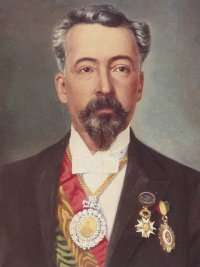Severo Fernández
| Severo Fernández | |
|---|---|
 | |
| President of Bolivia | |
|
In office 1896–1899 | |
| Preceded by | Mariano Baptista |
| Succeeded by | José Manuel Pando |
| Personal details | |
| Born |
Severo Fernández Alonso Caballero 15 August 1849 Sucre, Bolivia |
| Died | 12 August 1925 (aged 75) |
Severo Fernández Alonso Caballero (15 August 1849, Sucre – 12 August 1925) was President of Bolivia from 1896 to 1899. He is best remembered as the last president of the 15-year period of Conservative Party hegemony (1884–99).
Like his predecessor, Mariano Baptista, Fernández was a more conciliatory and legalist breed of Conservative. He presided over the collapse of Conservative Party rule and its loss of power in the aftermath of the 1899 Civil War against the Liberal Party. A disgruntled Liberal Party had become increasingly frustrated during the many years of Conservative dominance, often attained by electoral fraud. After 1894, led by the combative José Manuel Pando, a former military hero in the War of the Pacific, the Liberals' calls for anti-government rebellions became more strident, but they were always neutralized by a loyal military establishment.
All of this changed radically with the emergence of a new, and very polarizing, wedge issue: the simmering displeasure in the cities of Sucre and Potosi, dating back to the days of President Andrés de Santa Cruz (1829–39), regarding the de facto takeover by the city of La Paz as the seat of the Bolivian government. The regional conflict also had much to do with the emergence of a new tin-mining elite based in La Paz and Oruro, to the detriment of the old silver-mining establishment based in Sucre and Potosi, as symbolized by Conservative leaders such as Arce and Pacheco (both silver tycoons). To add fuel to the fire, the Liberals called for a federal decentralization of power, thus garnering further support from outlying regions of the country.
Civil War (often called the "Federal Revolution") exploded when Chuquisaca and Potosi parliamentarians in Sucre passed a "Law of Confinement," which ordered the President to reside in Sucre and issue decrees from there, rather than from La Paz. For their part, La Paz-Oruro-Cochabamba lawmakers associated with Pando's Liberal Party introduced a motion calling for the official transfer of the seat of Government to La Paz, legalizing what had in fact been customary practice for decades. When this motion was prevented from being voted on by the Conservatives, the Liberal congressmen left Sucre and established themselves permanently in La Paz. At this point President Fernández himself led an army to La Paz, in order to "restore order." The ensuing bloodbath culminated in the crushing defeat of the Conservatives at the hands of General Pando, who emerged triumphant from the Battle of the Second Crucero, even taking President Fernández prisoner.
Subsequently, Fernández was allowed to go into exile in Chile, but returned to Bolivia in his declining years, where he died in August 1925, a few days before his 76th birthday.
References
| Political offices | ||
|---|---|---|
| Preceded by Serapio Reyes Ortiz |
Vice President of Bolivia 1892–1896 |
Succeeded by Jenaro Sanjinés Calderón Rafael Peña de Flores |
| Preceded by Mariano Baptista |
President of Bolivia 1896–1899 |
Succeeded by José Manuel Pando |